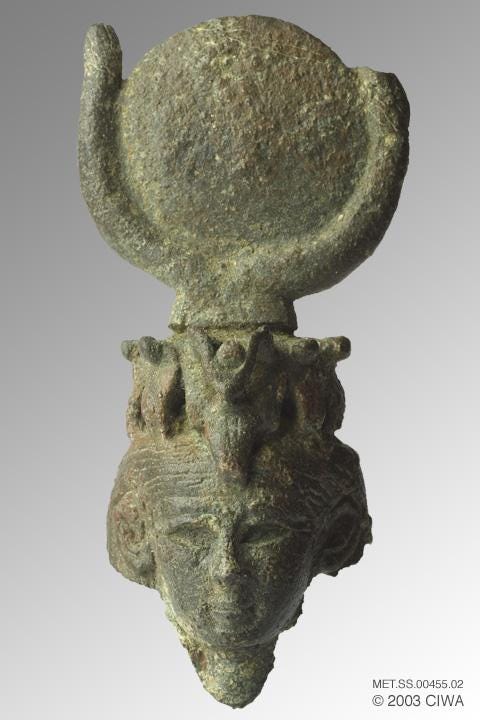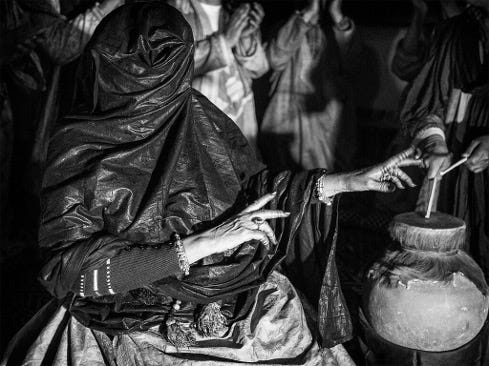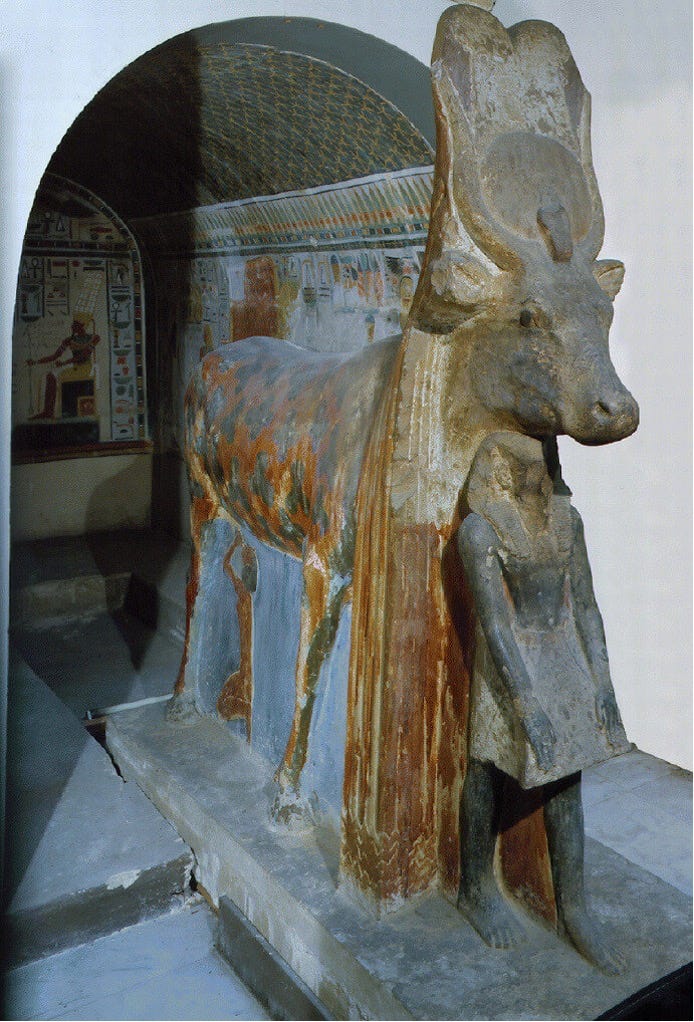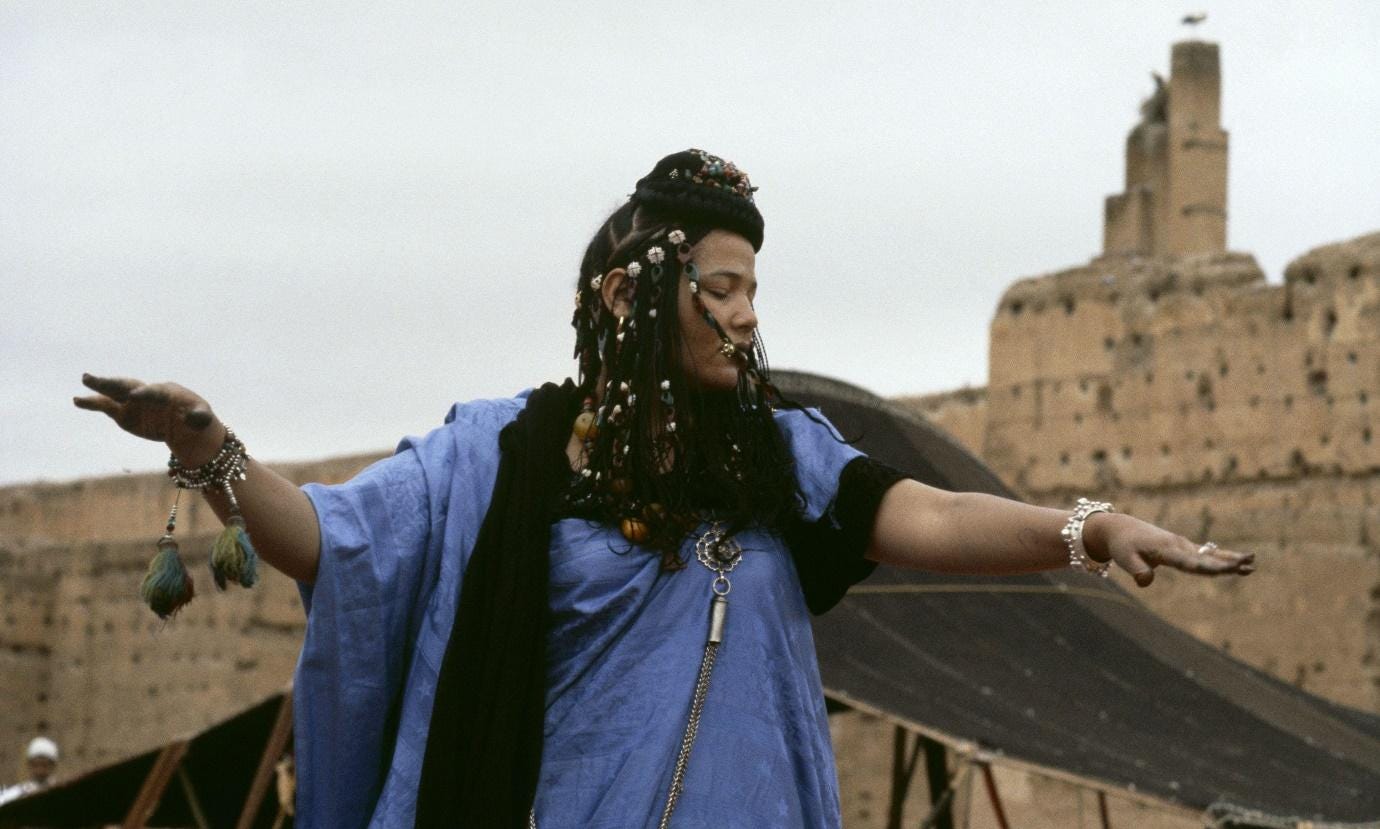This Black History Month, we celebrate the enduring influence of African dance traditions as sacred expressions of spirituality, identity, and resilience. In this article, Egyptologist and dancer Jendayi explores the ancient worship of Hathor and the trance dances of Nubia and the Maghreb, revealing their deep cultural and spiritual significance.
Imagine a vibrant festival in ancient Egypt: rhythmic drumming fills the air, feet stamp against the earth in hypnotic unison, and dancers sway and spin, their movements bridging the earthly and the divine. This was the essence of worship for Hathor, the goddess of joy, music, dance, fertility, and love. Far more than an act of celebration, dances were sacred rituals meant to connect the spirit of the dancer to the divine.
Hathor, an ancient Egyptian goddess of music and dance, was often depicted
as a woman with cow horns embracing a sun disk. Festivals in her honor were spectacular displays of devotion where music and movement intertwined to invoke her blessings. Skilled priestesses and dancers predominantly from Nubia performed rhythmic, trance-inducing movements designed to elevate participants beyond the mundane into a joyous, life-affirming spiritual ecstasy that dissolved the barriers between mortal and divine.
But Hathor’s story and in turn her worship is not confined to Egypt alone—it is deeply tied to Africa’s rich cultural and spiritual traditions.
The African Foundations of Hathoric Worship
Hathor’s worship reflects the profound cultural exchanges between Egypt and its African neighbors, particularly Nubia and the Maghreb. African dancers were pivotal in these rituals, their powerful movements immortalized in temple reliefs. These dancers didn’t merely entertain—they told spiritual stories, weaving devotion into every step and gesture and have endured through time in both Zar and Guedra.

The Guedra, a trance-inducing dance from the Maghreb, employs rhythmic hand and shoulder movements to create a communal spiritual experience.
The Zar, practiced in parts of Africa and the Middle East, serves as both a healing ritual and a connection to ancient traditions.
These dances, both ancient and modern, form an unbroken thread linking African spiritual practices to Hathoric worship, reminding us of the enduring power of movement as a tool for storytelling and connection.
Hathor, Hatshepsut, and Divine Leadership
Hathor’s influence was not limited to spirituality; it also shaped politics, particularly during the reign of Hatshepsut, one of Egypt’s most remarkable female pharaohs. Hatshepsut strategically aligned herself with Hathor to solidify her rule. At her stunning mortuary temple at Deir el-Bahari, Hatshepsut depicted herself in Hathor’s divine company, emphasizing her right to rule as divinely ordained and her ability to bridge femininity and power.

Hathoric ceremonies, featuring dance and music, were central to reinforcing this divine authority. Trance-inducing movements celebrated in Hathor’s name elevated Hatshepsut’s position as both a spiritual and political leader. This connection highlights the transformative role of dance and ritual in shaping narratives of leadership, especially for women defying traditional roles.
From the Past to the Present: My Personal Journey
As a dancer and Egyptologist, I’ve always been drawn to the profound intersections of movement, history, and spirituality. My dissertation, Shake, Rattle and Roll: The Appearance of African Spiritual and Trance Dances in Hathoric Worship, was born from over two decades of exploring dance’s transformative power. It allowed me to delve into the connections between ancient Egyptian culture and African spiritual practices, honoring the dancers and priestesses who considered movement a sacred act.
Now, I will bring these stories to life in a full-length theatrical production where I will share the story of Hathor, Hatshepsut and the role of trance dance in a modern, engaging way. This production will celebrate the history and spirituality of these ancient dances while shining a light on the enduring impact of African civilizations on global culture.
Honoring Dance as a Universal Language
Hathor’s worship and the cultural exchanges it embodies remind us that dance is more than art—it is a language that transcends time, space, and borders. These sacred movements, rooted in devotion and storytelling, link us to our ancestors and to each other.
This Black History Month, I invite you to reflect on the extraordinary contributions of African cultures to global traditions. Let us celebrate the resilience of marginalized voices, honor the beauty of our shared history, and recognize the power of dance to inspire, connect, and transform.
Whether in the vibrant festivals of Hathor’s worship or the modern echoes of African trance dances, the language of movement continues to speak to our hearts and spirits. Dance, after all, is how we tell the stories that words cannot capture.
About the Author
Jendayi
Jendayi is a dancer and Egyptologist with over 24 years of experience exploring dance traditions rooted in Ancient and Modern Egypt, the Maghreb region, and beyond. Her work is deeply tied to understanding the spiritual significance of these movements—rituals that celebrate the divine feminine and serve as a bridge to something greater than ourselves.
Specializing in the ancient temple dances of the New Kingdom, particularly those honoring Hathor, Jendayi has also studied modern spiritual practices such as Zar and Guedra, which continue the legacy of movement as a sacred expression. For her, dance is more than an art form—it is a transcendent experience where history, spirituality, and femininity intersect, shaping both her career and her life’s mission to connect ancient wisdom with contemporary understanding.













Insightful and provocative, this article creates visual images and encourages discussion.